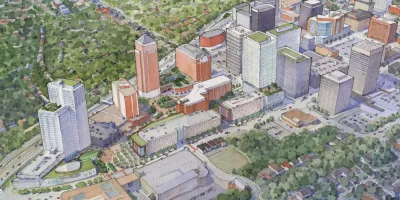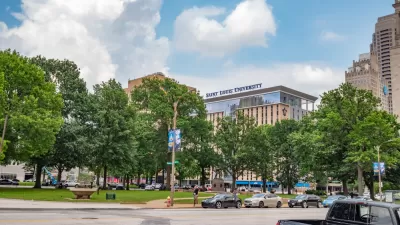The rare and elusive comprehensive planning review has been published by nextSTL.

Alex Ihnen critiques the plan for the proposed, $771.8 million Centene Clayton corporate campus, which recently had another in a series of well-attended public hearings. Ihnen writes the following preamble before launching into a comprehensive evaluation of the plans merits and demerits:
To premise the following critique, it needs to be conceded that the plan to develop vacant lots, and low-rise buildings into office towers in downtown Clayton is a good one. It’s better than good, it’s great. It has been an absurd sight as large swaths of vacant land have sat idle for a decade next to the region’s high-end business center, two MetroLink stations, and a Ritz-Carlton hotel. The $770M plan to add nearly 3,000 employees, residents, and retail to the city’s central business district is something to applaud.
Among the weaknesses of the plan, as evaluated by Ihnen, are the plan's effects on the street. "The design…completely abandons Hanley [Road] as a place for pedestrians," for instance, writes Ihnen. Moreover, "the campus master plan for employee circulation works hard to keep everyone inside, from garage to office and across the campus."
Another criticism posited by Ihnen: the need to increase the number of residential units proposed by the plan, to reduce traffic to the campus by allowing more people to live within walking distance. The plan has only taken steps in the opposite direction, according to Ihnen, decreasing from 135 to 119 in recent drafts.
Other themes of Ihnen's critique include public spaces, architecture, and NIMBYs. On that last count, Ihnen takes issue with "misplaced at best" criticisms by the opposition to the development.
FULL STORY: How Centene’s $770M Clayton Corporate Campus Project and NIMBY Opposition Fall Short

Planetizen Federal Action Tracker
A weekly monitor of how Trump’s orders and actions are impacting planners and planning in America.

Maui's Vacation Rental Debate Turns Ugly
Verbal attacks, misinformation campaigns and fistfights plague a high-stakes debate to convert thousands of vacation rentals into long-term housing.

Cuomo Is the Candidate of Both NIMBYs and Developers. What Gives?
In the New York City mayoral race, odd bedfellows align to preserve the housing status quo.

The Subversive Car-Free Guide to Trump's Great American Road Trip
Car-free ways to access Chicagoland’s best tourist attractions.

San Antonio and Austin are Fusing Into one Massive Megaregion
The region spanning the two central Texas cities is growing fast, posing challenges for local infrastructure and water supplies.

Charlottesville Temporarily Has No Zoning Code
A judge ordered the Virginia city to throw out its newly revised zoning code, leaving permitting for new development in legal limbo.
Urban Design for Planners 1: Software Tools
This six-course series explores essential urban design concepts using open source software and equips planners with the tools they need to participate fully in the urban design process.
Planning for Universal Design
Learn the tools for implementing Universal Design in planning regulations.
Heyer Gruel & Associates PA
JM Goldson LLC
Custer County Colorado
City of Camden Redevelopment Agency
City of Astoria
Transportation Research & Education Center (TREC) at Portland State University
Jefferson Parish Government
Camden Redevelopment Agency
City of Claremont





























